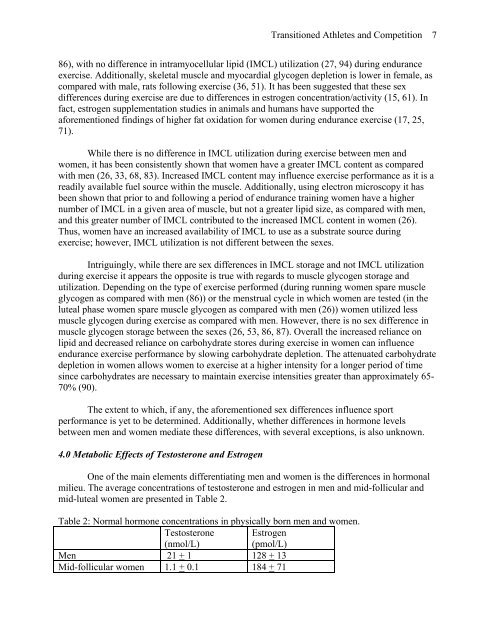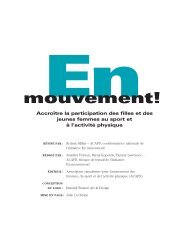Do Transitioned Athletes Compete at an Advantage or Disadvantage
Do Transitioned Athletes Compete at an Advantage or Disadvantage
Do Transitioned Athletes Compete at an Advantage or Disadvantage
You also want an ePaper? Increase the reach of your titles
YUMPU automatically turns print PDFs into web optimized ePapers that Google loves.
<strong>Tr<strong>an</strong>sitioned</strong> <strong>Athletes</strong> <strong>an</strong>d Competition 7<br />
86), with no difference in intramyocellular lipid (IMCL) utiliz<strong>at</strong>ion (27, 94) during endur<strong>an</strong>ce<br />
exercise. Additionally, skeletal muscle <strong>an</strong>d myocardial glycogen depletion is lower in female, as<br />
compared with male, r<strong>at</strong>s following exercise (36, 51). It has been suggested th<strong>at</strong> these sex<br />
differences during exercise are due to differences in estrogen concentr<strong>at</strong>ion/activity (15, 61). In<br />
fact, estrogen supplement<strong>at</strong>ion studies in <strong>an</strong>imals <strong>an</strong>d hum<strong>an</strong>s have supp<strong>or</strong>ted the<br />
af<strong>or</strong>ementioned findings of higher f<strong>at</strong> oxid<strong>at</strong>ion f<strong>or</strong> women during endur<strong>an</strong>ce exercise (17, 25,<br />
71).<br />
While there is no difference in IMCL utiliz<strong>at</strong>ion during exercise between men <strong>an</strong>d<br />
women, it has been consistently shown th<strong>at</strong> women have a gre<strong>at</strong>er IMCL content as compared<br />
with men (26, 33, 68, 83). Increased IMCL content may influence exercise perf<strong>or</strong>m<strong>an</strong>ce as it is a<br />
readily available fuel source within the muscle. Additionally, using electron microscopy it has<br />
been shown th<strong>at</strong> pri<strong>or</strong> to <strong>an</strong>d following a period of endur<strong>an</strong>ce training women have a higher<br />
number of IMCL in a given area of muscle, but not a gre<strong>at</strong>er lipid size, as compared with men,<br />
<strong>an</strong>d this gre<strong>at</strong>er number of IMCL contributed to the increased IMCL content in women (26).<br />
Thus, women have <strong>an</strong> increased availability of IMCL to use as a substr<strong>at</strong>e source during<br />
exercise; however, IMCL utiliz<strong>at</strong>ion is not different between the sexes.<br />
Intriguingly, while there are sex differences in IMCL st<strong>or</strong>age <strong>an</strong>d not IMCL utiliz<strong>at</strong>ion<br />
during exercise it appears the opposite is true with regards to muscle glycogen st<strong>or</strong>age <strong>an</strong>d<br />
utiliz<strong>at</strong>ion. Depending on the type of exercise perf<strong>or</strong>med (during running women spare muscle<br />
glycogen as compared with men (86)) <strong>or</strong> the menstrual cycle in which women are tested (in the<br />
luteal phase women spare muscle glycogen as compared with men (26)) women utilized less<br />
muscle glycogen during exercise as compared with men. However, there is no sex difference in<br />
muscle glycogen st<strong>or</strong>age between the sexes (26, 53, 86, 87). Overall the increased reli<strong>an</strong>ce on<br />
lipid <strong>an</strong>d decreased reli<strong>an</strong>ce on carbohydr<strong>at</strong>e st<strong>or</strong>es during exercise in women c<strong>an</strong> influence<br />
endur<strong>an</strong>ce exercise perf<strong>or</strong>m<strong>an</strong>ce by slowing carbohydr<strong>at</strong>e depletion. The <strong>at</strong>tenu<strong>at</strong>ed carbohydr<strong>at</strong>e<br />
depletion in women allows women to exercise <strong>at</strong> a higher intensity f<strong>or</strong> a longer period of time<br />
since carbohydr<strong>at</strong>es are necessary to maintain exercise intensities gre<strong>at</strong>er th<strong>an</strong> approxim<strong>at</strong>ely 65-<br />
70% (90).<br />
The extent to which, if <strong>an</strong>y, the af<strong>or</strong>ementioned sex differences influence sp<strong>or</strong>t<br />
perf<strong>or</strong>m<strong>an</strong>ce is yet to be determined. Additionally, whether differences in h<strong>or</strong>mone levels<br />
between men <strong>an</strong>d women medi<strong>at</strong>e these differences, with several exceptions, is also unknown.<br />
4.0 Metabolic Effects of Testosterone <strong>an</strong>d Estrogen<br />
One of the main elements differenti<strong>at</strong>ing men <strong>an</strong>d women is the differences in h<strong>or</strong>monal<br />
milieu. The average concentr<strong>at</strong>ions of testosterone <strong>an</strong>d estrogen in men <strong>an</strong>d mid-follicular <strong>an</strong>d<br />
mid-luteal women are presented in Table 2.<br />
Table 2: N<strong>or</strong>mal h<strong>or</strong>mone concentr<strong>at</strong>ions in physically b<strong>or</strong>n men <strong>an</strong>d women.<br />
Testosterone<br />
(nmol/L)<br />
Estrogen<br />
(pmol/L)<br />
Men 21 + 1 128 + 13<br />
Mid-follicular women 1.1 + 0.1 184 + 71






